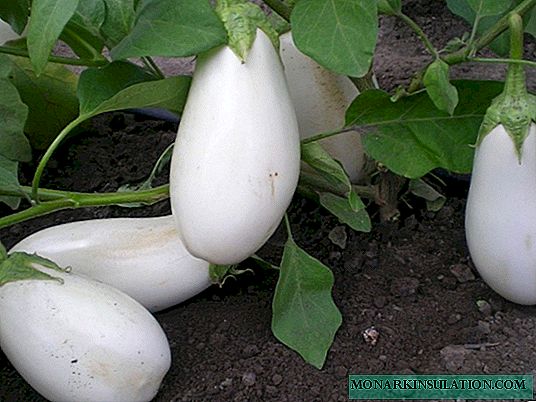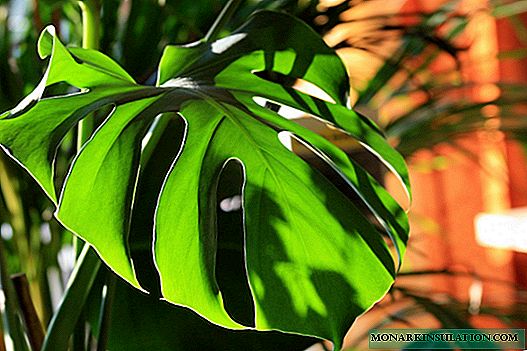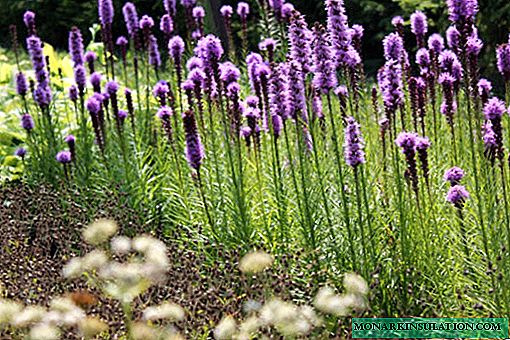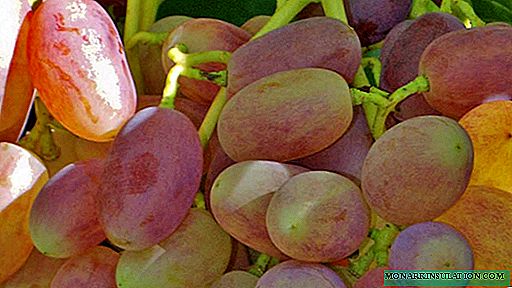
Beloved by many lovers of grapes - a primordially southern plant. Nevertheless, many varieties adapted for cultivation in more severe climates are currently bred. One of the most popular domestic varieties combining winter hardiness and high productivity is the Victor hybrid, which produces very early and large yields.
The history of growing grapes Victor
Grapes Victor is a hybrid form not registered in the State Register. This relatively "young" variety was bred in 2000-2002 by the Kuban amateur breeder V.N. Kraynov based on the crossing of Kishmish the radiant and the Talisman.
Despite the relatively short history of its existence, Victor gained popularity among winegrowers practically throughout Russia thanks to good indicators of frost resistance and productivity. In amateur descriptions, he is even awarded the title of premium grapes.
Comparison of Victor grapes with other V. Krainov hybrids - video
Variety description Victor
Victor belongs to early table varieties - grape harvesting can begin in the first half of August (100-110 days after the start of the growing season).
The vines are powerful, well developed, and grow quite quickly. Each vine has many large buds. The flowers are bisexual, begin to bloom in early June. At the height of flowering, leaf pruning can be carried out, which allows you to get larger clusters and increase the total yield.
Bunches of grapes Victor in the photo

- When fully ripened, Victor's clusters turn dark pink.

- The size of the bunch of grapes Victor is very impressive

- With very good lighting, the skin of the berries becomes purple
The clusters reach a very solid size (600-1100 g) and have a conical shape, although sometimes they are shapeless. Their structure is loose. Berries ripen evenly. The berries are very large - they can be about 4 cm long, sometimes up to 6 cm, and the mass of one berry reaches 16-18 g. The shape of Victor’s berries is similar to a lady’s finger. The skin color can vary from greenish pink to dark purple, depending on the degree of ripeness and lightness.
The pulp is dense and elastic, with high juiciness, tastes pleasantly sweet with a slight acidity. Sugar content is 17%, acid - 8 g / l. The peel with all its density is quite thin and is not felt when eating fresh berries.
Grapes Victor on video
Characteristics of Victor grapes
Victor grapes are characterized by a number of advantages:
- self-pollination;
- high productivity (6-7 kg from 1 bush);
- resistance to transportation and good keeping quality;
- excellent tastes and beautiful appearance;
- good resistance to low temperatures (up to -22 ... -25 aboutFROM);
- low susceptibility to diseases and pests.
Among the negative traits of the variety, early flowering periods can be noted, which jeopardize the crop during spring frosts and susceptibility to attack by wasps.
Planting and growing rules
The technology for growing Victor grapes differs little from growing other varieties.
Landing
When choosing a place for planting Victor grapes, it must be borne in mind that this variety does not like stagnation of cold air and drafts and very much needs good lighting. It is best to plant grapes on a small hill from the south or southwest side of the site. It is undesirable to land close to buildings or trees. The distance to neighboring bushes and trees should be 5-6 m.
The soil is preferably light, well-permeable, although Victor can grow on any soil. It should be borne in mind that the volume and quality of the crop will depend on the quality of the soil. The close occurrence of groundwater adversely affects the root system of grapes.
The best time for planting grapes is spring, although in the southern regions with the late onset of cold weather, you can plant in the autumn.
Victor grapes can be planted in different ways - using seedlings, cuttings or cuttings, as well as sowing seeds. With any method of planting, grapes take root perfectly.
Seeding with seeds is a fairly reliable way in which you can get a plant that completely repeats the properties of the mother. The only drawback is the long wait for fruiting.
Growing grapes from seeds - video
For grafting the cuttings, it is necessary to prepare in advance (from autumn) cuttings having at least 2-3 eyes and a perfectly clean cut. For storage, the cuttings need to be waxed - this will not only protect the cut from drying out, but also enhance the adaptability of the cuttings. Store prepared material in the refrigerator. In the spring, cuttings of the cuttings are refreshed and grafted into a split adult stump-stock.

With a successful vaccination, the buds on the cuttings give foliage and grow
For the reproduction of grapes Victor layering you need to choose a long, well-developed vine, lay it in a pre-prepared trench 30-35 cm deep and sprinkle with earth. The end of the vine is released at the desired distance from the uterine bush and tied to a support. The layering must be well watered so that it gives roots.

With the help of layering, you can get a number of grape bushes.
Planting grapes with seedlings is available to any gardener. If you get a ready-made seedling, pay special attention to the root system - it must be developed, with white lateral branches. With the help of seedlings. Seedlings can be grown independently if you place cuttings with 4-5 eyes in water or moist soil in February. By May, the seedling will be ready for planting in the ground.

Grapes cut into water quickly give root
A grape pit is prepared in advance (2-3 weeks before planting) so that the soil settles. The size of the pit should be no less than 80 cm by 80 cm. A third of the height of the pit is filled with a nutrient mixture of fertile soil and humus with the addition of a small amount of nitrogen fertilizer and wood ash. A mixture of fertilizers is covered with soil (2-3 cm layer). The seedling is placed carefully in the pit, as young (white) roots are very fragile, sprinkled with soil, compacted, water the planting and mulch the soil with sawdust or peat.
Planting grapes - video
When planting in cold regions, place the bush under the protection of the wall, be sure to put a drainage layer of expanded clay or broken brick on the bottom of the pit, and trim the boards (they will protect the roots from the cold) on top of it. At a distance of 50-60 cm from the center of the pit, install pipe trunks to water them under the root with warm water.

When planting in cold areas, it is necessary to protect the roots from groundwater and deep cold using a drainage layer and pieces of boards
Care for grape bushes
Planting care consists of watering, fertilizing, pruning and protection from pests and diseases.
Victor possesses good winter hardiness and needs to be covered for the winter only in cold regions (at temperatures below -22 ... -23 in winter aboutFROM). For shelter, the vines are bent to the ground, tied together and covered with a film, straw or sprinkled with soil.

To protect against winter cold, you can sprinkle vines lowered to the ground with soil
In the spring, after the snow cover has disappeared (usually in April), the winter shelter must be removed, the vines must be raised and secured to the trellises. Hybrid Victor has a high growth rate, so it is necessary to trim in time for the formation of the bush and rationing the crop. Pruning can be carried out both short (for 3-4 kidneys), and long (for 8-10 kidneys). As a result, 25-35 eyes should remain on the bush. Young shoots are tied to supports as they grow, and the extra stepsons are broken down.

For normal development, grapes must be tied to trellises
In summer, you need to pinch the vine regularly and prevent it from growing more than 1.6-1.8 m. In mid-summer, when the bunches begin to ripen, it is recommended to pick leaves to provide access to sunlight for berries.
You need to water the grapes regularly in the first year of life. Good rooting of a seedling requires constant moderate soil moisture, which is achieved by watering every 7-10 days. Excessive moisture should be avoided to prevent root decay.
Adult grape bushes do not need frequent watering. 2-3 waterings per season are sufficient (in very dry weather this number is increased).
It is not recommended to water and feed the grapes before flowering! In this case, the nutrients will go on building green mass.
Vineyard dressing is carried out 3-4 times per season: after flowering, during the growth of berries and after harvesting. A good fertilizer option is a mixture of superphosphate (30-35 g), ash (50-60 g), manure (2 kg) and a bucket of water. The indicated amount of fertilizer is applied to each square meter of the barreled circle.
In an adult Victor grape bush, the nutritional area is approximately 6-6.5 m2.
Pest and disease protection
One of the main advantages of the Victor hybrid is its high resistance to such common diseases as gray rot, oidium and mildew. Nevertheless, it is better to make 2-3 preventative treatments in order to preserve the crop for sure.
The best time for preventive spraying is the period before flowering, and then the stage of berry growth. The last treatment is carried out before shelter for the winter.
For the prevention of fungal diseases, fungicides are recommended: Tiovit Jet, sulfur Oksikhom, Thanos. For the winter, once every 3 years, they are treated with DNOC or Nitrafen.
Of the pests, wasps are the most dangerous, attracted by early ripening sweet berries. Some gardeners recommend hanging traps for wasps on vines - a honey solution with insecticide additives. However, this method can harm other insects (for example, bees). To protect against wasps, you can use another, very reliable, although time-consuming way - to tie each brush with a bag of light fabric. This operation is carried out 7-10 days before the onset of technical ripeness.
Harvesting and Harvesting
In the first decade of August (later in the northern regions), you can start harvesting. The ripeness of the berries can be determined by the color of the skin - it should acquire a pink tint. However, clusters growing in the shade may not get the color, so ripeness is best determined by taste.
Clusters cannot be broken off - they are cut with a pruner, leaving a “leg” 4-5 cm long. For transportation, the crop must be packed as tightly as possible in baskets or wooden boxes.
You can save fresh grapes by hanging the bunches in a cool, dark room. There they can last 2-3 months.

Freshly squeezed grape juice is not only tasty, but also a healthy drink
Basically, Victor berries are intended for fresh consumption, but are also suitable for making wines, juices, raisins.
Gardeners reviews
Victor leaves no one indifferent. Individual berries reach a size of 52 mm. Highly resistant - this year it took one preventive spraying. The buds were opened after wintering by 100%. The berries began to stain. The number will reach maturity by August 5-8. Miracle!
Yu.D.//forum.vinograd.info/showthread.php?t=3646
Victor is a hybrid hybrid table form of grape of amateur selection (Kraynov VN) of very early or early ripening, in the conditions of the city of Novocherkassk it ripens in early August. Bushes of great vigor. The clusters are large, weighing 500 -1000 g, medium density. The berries are very large, 9-14 g, long with a slightly pointed tip, pink in color, harmonious taste. The pulp is fleshy and juicy. Shoots ripen well. Resistance gf Victor to fungal diseases and frost is being studied.
Dowsing rod//www.vinograd777.ru/forum/showthread.php?t=466
Victor is a magnificent grape, but very afraid of overload.
Alexander Mumanzhinov//www.vinograd777.ru/forum/showthread.php?t=466
G.F. Root-owning Victor for the third year gave out 3 clusters of 600 g each, the growth force showed medium, but last year grafted on Moldova ("black in green") gave out 6 clusters this year on average 1.2 kg of the main crop and the weight of the stepson. From of what I left, 8kg ripened completely, and 5 kg was removed unripe at the end of September. Of course, we must take into account that September was freezing. As for the growth force, it will obviously continue to be very crowded on the three meters of trellis with two coinage the most powerful in thickness and length up to 4 m.
Victor51//www.vinograd777.ru/forum/showthread.php?t=466
I want to share my first impressions. I bought Victor in the spring with a growing seedling. To date, the growth of 2 vines 4 meters by 4 + green cuttings rooting is just excellent rooting my first experience. Resistance to diseases is better than that of Arcadia (planted nearby) with the same care
Hunter//forum.vinograd.info/showthread.php?t=3646
Resistant to disease and frost, early ripe grapes Victor will decorate any garden. You only need to correctly prune and normalize the load on the bushes, feed plants in a timely manner and protect your crop from gluttonous wasps. Subject to these simple rules, grapes will delight you with large and tasty berries.














